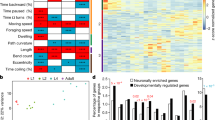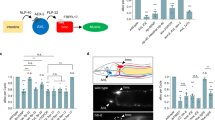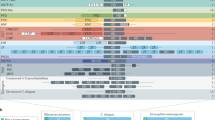Abstract
The epidermal growth factor receptor (EGFR)/ErbB receptor tyrosine kinases regulate several aspects of development, including the development of the mammalian nervous system. ErbB signaling also has physiological effects on neuronal function, with influences on synaptic plasticity and daily cycles of activity. However, little is known about the effectors of EGFR activation in neurons. Here we show that EGF signaling has a nondevelopmental effect on behavior in Caenorhabditis elegans. Ectopic expression of the EGF-like ligand LIN-3 at any stage induces a reversible cessation of feeding and locomotion. These effects are mediated by neuronal EGFR (also called LET-23) and phospholipase C–γ (PLC-γ), diacylglycerol-binding proteins, and regulators of synaptic vesicle release. Activation of EGFR within a single neuron, ALA, is sufficient to induce a quiescent state. This pathway modulates the cessation of pharyngeal pumping and locomotion that normally occurs during the lethargus period that precedes larval molting. Our results reveal an evolutionarily conserved role for EGF signaling in the regulation of behavioral quiescence.
This is a preview of subscription content, access via your institution
Access options
Subscribe to this journal
Receive 12 print issues and online access
$209.00 per year
only $17.42 per issue
Buy this article
- Purchase on Springer Link
- Instant access to full article PDF
Prices may be subject to local taxes which are calculated during checkout




Similar content being viewed by others
References
Buonanno, A. & Fischbach, G.D. Neuregulin and ErbB receptor signaling pathways in the nervous system. Curr. Opin. Neurobiol. 11, 287–296 (2001).
Huang, Y.Z. et al. Regulation of neuregulin signaling by PSD-95 interacting with ErbB4 at CNS synapses. Neuron 26, 443–455 (2000).
Kwon, O-B., Longart, M., Vullhorst, D., Hoffman, D.A. & Buonanno, A. Neuregulin-1 reverses long-term potentiation at CA1 hippocampal synapses. J. Neurosci. 25, 9378–9383 (2005).
Kramer, A. et al. Regulation of daily locomotor activity and sleep by hypothalamic EGF receptor signaling. Science 294, 2511–2515 (2001).
Snodgrass-Belt, P., Gilbert, J.L. & Davis, F.C. Central administration of transforming growth factor–alpha and neuregulin-1 suppress active behaviors and cause weight loss in hamsters. Brain Res. 1038, 171–182 (2005).
Jorissen, R.N. et al. Epidermal growth factor receptor: mechanisms of activation and signalling. Exp. Cell Res. 284, 31–53 (2003).
Hill, R.J. & Sternberg, P.W. The gene lin-3 encodes an inductive signal for vulval development in C. elegans. Nature 358, 470–476 (1992).
Aroian, R.V., Koga, M., Mendel, J.E., Ohshima, Y. & Sternberg, P.W. The let-23 gene necessary for Caenorhabditis elegans vulval induction encodes a tyrosine kinase of the EGF receptor subfamily. Nature 348, 693–699 (1990).
Moghal, N. & Sternberg, P.W. The epidermal growth factor system in Caenorhabditis elegans. Exp. Cell Res. 284, 150–159 (2003).
Clandinin, T.R., DeModena, J.A. & Sternberg, P.W. Inositol trisphosphate mediates a RAS-independent response to LET-23 receptor tyrosine kinase activation in C. elegans. Cell 92, 523–533 (1998).
Yin, X., Gower, N.J.D., Baylis, H.A. & Strange, K. Inositol 1,4,5-trisphosphate signaling regulates rhythmic contractile activity of myoepithelial sheath cells in Caenorhabditis elegans. Mol. Biol. Cell 15, 3938–3949 (2004).
Katz, W.S., Hill, R.J., Clandinin, T.R. & Sternberg, P.W. Different levels of the C. elegans growth factor LIN-3 promote distinct vulval precursor fates. Cell 82, 297–307 (1995).
Johnson, T.E., Mitchell, D.H., Kline, S., Kemal, R. & Foy, J. Arresting development arrests aging in the nematode Caenorhabditis elegans. Mech. Ageing Dev. 28, 23–40 (1984).
Timmons, L., Court, D.L. & Fire, A. Ingestion of bacterially expressed dsRNAs can produce specific and potent genetic interference in Caenorhabditis elegans. Gene 263, 103–112 (2001).
Yang, C. & Kazanietz, M.G. Divergence and complexities in DAG signaling: looking beyond PKC. Trends Pharmacol. Sci. 24, 602–608 (2003).
Tabuse, Y. Protein kinase C isotypes in C. elegans. J. Biochem. 132, 519–522 (2002).
van der Linden, A.M., Moorman, C., Cuppen, E., Korswagen, H.C. & Plasterk, R. Hyperactivation of the G12-mediated signaling pathway in Caenorhabditis elegans induces a developmental growth arrest via protein kinase C. Curr. Biol. 13, 516–521 (2003).
Richmond, J.E., Weimer, R.M. & Jorgensen, E.M. An open form of syntaxin bypasses the requirement for UNC-13 in vesicle priming. Nature 412, 338–341 (2001).
Richmond, J.E., Davis, W.S. & Jorgensen, E.M. UNC-13 is required for synaptic vesicle fusion in C. elegans. Nat. Neurosci. 2, 959–964 (1999).
Avery, L. & Horvitz, H.R. Pharyngeal pumping continues after laser killing of the pharyngeal nervous system of C. elegans. Neuron 3, 473–485 (1989).
Saifee, O., Wei, L.P. & Nonet, M.L. The Caenorhabditis elegans unc-64 locus encodes a syntaxin that interacts genetically with synaptobrevin. Mol. Biol. Cell 9, 1235–1252 (1998).
Weimer, R.M. et al. Defects in synaptic vesicle docking in unc-18 mutants. Nat. Neurosci. 6, 1023–1030 (2003).
Avery, L., Bargmann, C.I. & Horvitz, H.R. The Caenorhabditis elegans unc-31 gene affects multiple nervous system-controlled functions. Genetics 134, 455–464 (1993).
Ann, K., Kowalchyk, J.A., Loyet, K.M. & Martin, T.F.J. Novel Ca2+-binding protein (CAPS) related to UNC-31 required for Ca2+-activated exocytosis. J. Biol. Chem. 272, 19637–19640 (1997).
Treinin, M. & Chalfie, M. A mutated acetylcholine receptor subunit causes neuronal degeneration in C. elegans. Neuron 14, 871–877 (1995).
Albertson, D.G. & Thomson, J.N. The pharynx of Caenorhabditis elegans. Phil. Trans. R. Soc. Lond. B 275, 299–325 (1976).
Keane, J. & Avery, L. Mechanosensory inputs influence Caenorhabditis elegans pharyngeal activity via ivermectin sensitivity genes. Genetics 164, 153–162 (2003).
Avery, L. The genetics of feeding in Caenorhabditis elegans. Genetics 133, 897–917 (1993).
Raizen, D.M., Cullison, K.M., Pack, A.I. & Sundaram, M. A novel gain-of-function mutant of the cGMP-dependent protein kinase egl-4 affects multiple physiological processes in C. elegans. Genetics 173, 177–187 (2006).
Nonet, M.L., Saifee, O., Zhao, H., Rand, J.B. & Wei, L. Synaptic transmission deficits in C. elegans synaptobrevin mutants. J. Neurosci. 18, 70–80 (1998).
Okkema, P.G., Harrison, S.W., Plunger, V., Aryana, A. & Fire, A. Sequence requirements for myosin gene expression and regulation in Caenorhabditis elegans. Genetics 135, 385–404 (1993).
Garcia, R.A., Vasudevan, K. & Buonanno, A. The neuregulin receptor ErbB-4 interacts with PDZ-containing proteins at neuronal synapses. Proc. Natl. Acad. Sci. USA 97, 3596–3601 (2000).
Aroian, R.V., Lesa, G.M. & Sternberg, P.W. Mutations in the Caenorhabditis elegans let-23 EGFR-like gene define elements important for cell-type specificity and function. EMBO J. 13, 360–366 (1994).
Kaech, S.M., Whitfield, C.W. & Kim, S.K. The LIN-2/LIN-7/LIN-10 complex mediates basolateral membrane localization of the C. elegans EGF receptor LET-23 in vulval epithelial cells. Cell 94, 761–771 (1998).
Simske, J.S., Kaech, S.M., Harp, S.A. & Kim, S.K. LET-23 receptor localization by the cell junction protein LIN-7 during C. elegans vulval induction. Cell 85, 195–204 (1996).
Chang, C., Newman, A.P. & Sternberg, P.W. Reciprocal EGF signaling back to the uterus from the induced C. elegans vulva coordinates morphogenesis of epithelia. Curr. Biol. 9, 237–246 (1999).
Pujol, N., Torregrossa, P., Ewbank, J.J. & Brunet, J.-F. The homeodomain protein CePHOX2/CEH-17 controls antero-posterior axonal growth in C. elegans. Development 127, 3361–3371 (2000).
Popovici, C., Isnardon, D., Birnbaum, D. & Roubin, R. Caenorhabditis elegans receptors related to mammalian vascular endothelial growth factor receptors are expressed in neural cells. Neurosci. Lett. 329, 116–120 (2002).
Hwang, B.J. & Sternberg, P.W. A cell-specific enhancer that specifies lin-3 expression in the C. elegans anchor cell for vulval development. Development 131, 143–151 (2004).
Cassada, R.C. & Russell, R.L. The dauerlarva, a post-embryonic developmental variant of the nematode C. elegans. Dev. Biol. 46, 326–342 (1975).
Lesa, G.M. & Sternberg, P.W. Positive and negative tissue-specific signaling by a nematode epidermal growth factor receptor. Mol. Biol. Cell 8, 779–793 (1997).
Cronin, C.J. et al. An automated system for measuring parameters of nematode sinusoidal movement. BMC Genet. 6, 5 (2005).
Majewski, H. & Iannazzo, L. Protein kinase C: A physiological mediator of enhanced transmitter output. Prog. Neurobiol. 55, 463–475 (1998).
Rhee, J.-S. β-phorbol ester and diacylglycerol-induced augmentation of transmitter release is mediated by Munc13s and not by PKCs. Cell 108, 121–133 (2002).
Kim, K. & Li, C. Expression and regulation of an FMRFamide-related neuropeptide gene family in Caenorhabditis elegans. J. Comp. Neurol. 475, 540–550 (2004).
Dutt, A., Canevascini, S., Froehli-Hoier, E. & Hajnal, A. EGF signal propagation during C. elegans vulval development mediated by ROM-1 Rhomboid. PLoS Biol. 2, e334 (2004).
Wong, R.W.C. & Guillaud, L. The role of epidermal growth factor and its receptors in mammalian CNS. Cytokine Growth Factor Rev. 15, 147–156 (2004).
Brenner, S. The genetics of Caenorhabditis elegans. Genetics 77, 71–94 (1974).
Stringham, E.G., Dixon, D.K., Jones, D. & Candido, E.P. Temporal and spatial expression patterns of the small heat shock (hsp16) genes in transgenic Caenorhabditis elegans. Mol. Biol. Cell 3, 221–233 (1992).
Acknowledgements
We thank the Caenorhabditis Genetics Center for providing strains, S. Kim (Stanford University School of Medicine) for anti-LET-23 antibody, J. DeModena for antibody staining, S. Xu (Univ. Michigan) for the plc-3(sy698) allele, S. Mitani (Tokyo Women's Medical University School of Medicine) for the plc-3(tm1340) allele, N. Moghal, M. Kato, and S. Xu for critical reading of the manuscript, and C.J. Cronin for help with the automated tracking system and locomotion data analysis. This work was supported by a California Breast Cancer Research Program fellowship to C.V.B., by a US National Institute on Drug Abuse grant (DA018341) to P.W.S., and by the Howard Hughes Medical Institute, with which C.V.B. is an Associate and P.W.S. is an Investigator.
Author information
Authors and Affiliations
Contributions
C.V.B. designed and conducted the experiments and wrote the manuscript; P.W.S. supervised the project.
Corresponding author
Supplementary information
Supplementary Text and Figures
Supplementary Figures 1–4, Tables 1–4, and Methods (PDF 2524 kb)
Supplementary Video 1
Wild-type pharyngeal pumping (MOV 651 kb)
Supplementary Video 2
hs:LIN-3 inhibits pharyngeal pumping (MOV 823 kb)
Supplementary Video 3
Wild-type locomotion (MOV 2327 kb)
Supplementary Video 4
hs:LIN-3 severely impairs locomotion (MOV 2357 kb)
Supplementary Video 5
LIN-3 animals move normally when prodded (MOV 2135 kb)
Rights and permissions
About this article
Cite this article
Van Buskirk, C., Sternberg, P. Epidermal growth factor signaling induces behavioral quiescence in Caenorhabditis elegans. Nat Neurosci 10, 1300–1307 (2007). https://doi.org/10.1038/nn1981
Received:
Accepted:
Published:
Issue Date:
DOI: https://doi.org/10.1038/nn1981
This article is cited by
-
A quiescent state following mild sensory arousal in Caenorhabditis elegans is potentiated by stress
Scientific Reports (2020)
-
RPamide neuropeptides NLP-22 and NLP-2 act through GnRH-like receptors to promote sleep and wakefulness in C. elegans
Scientific Reports (2020)
-
Exploring phylogeny to find the function of sleep
Nature Reviews Neuroscience (2019)
-
A microfluidic-induced C. elegans sleep state
Nature Communications (2019)
-
Normal sleep bouts are not essential for C. elegans survival and FoxO is important for compensatory changes in sleep
BMC Neuroscience (2018)



